Most children aren’t able to complete hikes on their own until they are around 3-4 years old. So, if you want to go hiking with your baby or toddler, you will need a good hiking stroller or a carrier. As far as carriers go, the first thing to decide is whether you need a soft carrier or a framed backpack-style child carrier for hiking.
The short answer:
For infants and young babies, a front-facing soft carrier is best for hiking; you’ll be able to constantly see your baby and easily access supplies in a pack you wear on your back. Once your child gets to be around 1 year old, a framed carrier is much more comfortable for you and your child. Framed child carriers usually are best for toddlers too. However, if you are only going on short hikes and your toddler will be walking, a soft carrier is more practical to bring along as a backup in case your kid needs to be carried.
Infants: Front-Facing Soft Hiking Carrier
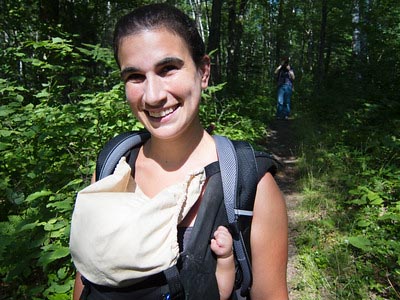
Babies must be able to sit up on their own to go in a backpack hiking carrier. So, until at least six months old, you will have to use a soft carrier for your baby. Luckily, at this age, babies aren’t very heavy so weight distribution isn’t an issue. However, some soft infant carriers are better than others for hiking.
Ring Slings: Not recommended
Ring slings are generally not a good choice for hiking for many reasons. First off, they are HOT for you and your baby. Because they are only worn over one shoulder, so you aren’t very balanced. And, while you can roll up the tail as a neck support, it doesn’t provide great support for babies when you are on bumpy terrain. The fabric can limit your arm motion, which isn’t great in situations where you need to use trekking poles – which you probably should be using (here’s why).
Wraps: Not recommended
Baby wraps can work for hiking, but generally get too hot for both you and your baby. Depending on the wrap style, it can also be difficult to wear a backpack with the wrap on. As with ring slings, many wraps limit your shoulder motion and make it difficult to use trekking poles properly.
Meh Dai/Mei Tai: Recommended
I used one of these for hiking with my baby and was mostly happy with it. While it does take some practice to use, the carrier distributes weight well and is highly adjustable for different sizes of babies and parents. I also like that it isn’t too bulky.
Honestly, a soft structured carrier would have been better for hiking, but I already had the mei tai (which I was using for everyday life) and didn’t want to buy a separate hiking carrier. So, it was “good enough.” The downside is that the long straps drag on the ground when putting it on – not ideal when hiking in muddy areas or snow.
Soft Structured Carrier: Recommended
These carriers include brands like ErgoBaby and BabyBjorn. They have wide waist bands and adjustable buckles to all you to carry a baby in multiple positions. While they are bulky and pricy, they are good at distributing weight. I also feel they do a better job of supporting the baby’s head.
6-9 Months: Soft Structured Hiking Carrier
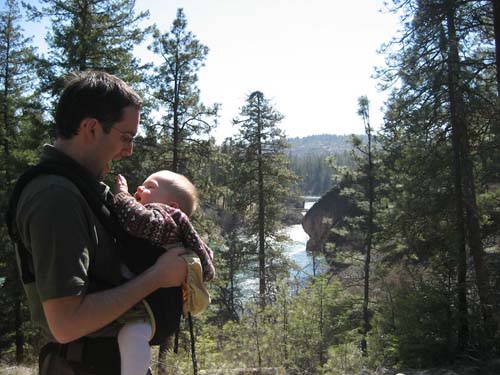
8 month baby in a front-facing soft carrier
While most babies can go into a backpack hiking carrier at this age, a soft structured carrier is probably the better option. The main reason is because 6-9 month old babies still sleep a lot. Even though good backpack carriers have built-in pillows/chin rests, your baby’s head will still sit weirdly in the carrier. If the trail is rough, their little head will probably bounce around a bit too.
Personally, I also found it easier to use a front carrier at this age than a backpack carrier. It’s easier to check on the baby – especially if you want to catch poops early so it doesn’t leak out of the diaper (carriers inevitably push on the crotch and make diaper leaks more likely). Breastfeeding is also a lot easier when you don’t have to completely remove a backpack carrier and take your fussy child out of it, and then get them back in.
Because your child is starting to get a bit heavier at this age, a soft structured carrier is probably the best option for hiking. However, you can still get away with using a mei tai carrier.
9-18 Months: Framed Backpack Carrier
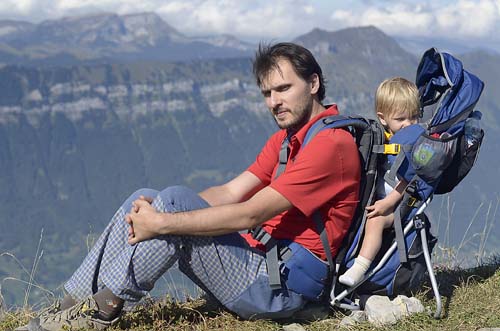
The Deuter Kid Comfort hiking carrier. Get it here at Amazon or here at REI
If you are going to go on any serious hikes or hike frequently, you’ll absolutely want a framed backpack carrier at this age. Yes, you could get by with a soft carrier at this age/weight, but the framed backpack carriers do a much better job of distributing weight and helping you stay balanced. They will save your back a lot of strain!
Backpack hiking carriers are also more comfortable for your child at this age. There are feet stirrups on the carrier so your child has somewhere to put their legs while hiking. Otherwise, their legs will dangle – potentially kicking your sides – and their crotch gets jammed into carrier in an uncomfortable way.
The downsides of a framed hiking carrier is that they are bulky. You won’t be able to use them for everyday tasks, like going to the grocery store. Also, all the storage (aside from maybe a hip belt pocket) is at the back. If you want to reach anything from the pack, you’ll have to ask a partner or completely remove the pack. I highly recommend getting a backpack carrier with a water bladder compartment so you can at least get a drink without having to remove the carrier each time.
Tip: You can sometimes find really good deals on child carrier backpacks and other outdoor baby gear at REI’s Online Outlet.
18+ Months: It Depends on How You Hike…
Here’s where the choice of a soft vs. framed child carrier gets complicated. At around this age, toddlers become less willing to sit in a carrier for an entire hike. They will want to walk around on their own, but you’ll probably end up carrying them for at least part of the hike.
Kids also start getting very heavy at this age. A soft carrier doesn’t do a good job of distributing the weight, so your back can start hurting very quickly. But backpack carriers are heavy in their own right, which is an issue for petite women like myself.
My recommendation for this age is:
- Soft carrier for short hikes: You can let your child walk most of the hike themselves. The soft carrier is small enough to go in your pack and take out when your child needs a break.
- Backpack carrier for serious hikes: This is the only way you can realistically carry a toddler for longer hikes or on rough terrain. A soft carrier just won’t give the support needed; they get uncomfortable quickly!
- Hiking stroller for heavy children: Be realistic – do you really think you can carry your 30+lb toddler plus gear for a long hike? It might make sense to stick to stroller-friendly hikes until your child gets a bit older and can complete more of the hike on their own.
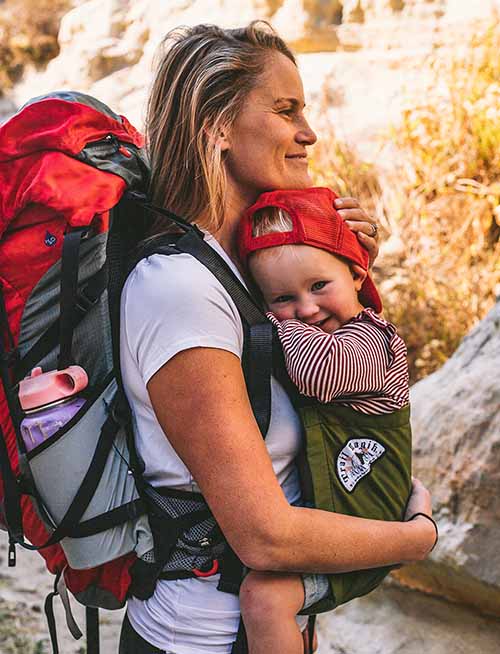
The brand TrailMagik makes a soft carrier for backpacking. It attaches to your backpack, which means it is much smaller and lighter than most other hiking carriers.
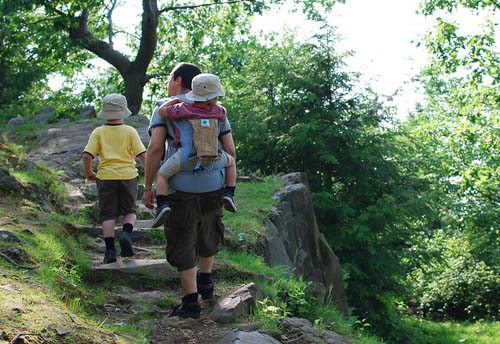
Soft carrier being used as a backup for when this toddler got too tired to walk
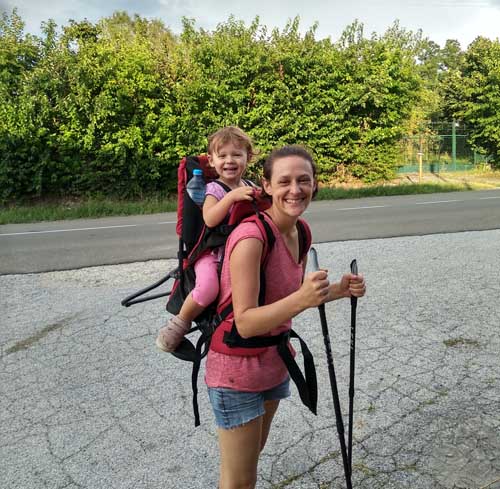
My two-year old excited for a hike in her framed backpack carrier.
Recommendations:
- Soft carriers: I recommend the ErgoBaby 360 Omni Cool Air.
- Lightweight carrier: The TrailMagik carrier attaches to your backpack, which means it doesn’t need to have its own hip belt and saves you a lot of weight and space.
- Frame backpack carriers: The Deuter Kid Comfort and Osprey Poco are great. They are available here at REI.
- Petite women: The Deuter KC Active SL version is made for women. Get it here at Amazon or here at REI
Also read:
- Tips for Using a Backpack Child Carrier
- Stroller vs. Carrier for Hiking
- Best Hiking Carriers for Petite Women
Resources:
https://www.lonelyplanet.com/thorntree/forums/kids-to-go/topics/frame-backpack-or-soft-carrier-for-toddler
https://hikeitbaby.com/blog/why-you-need-a-new-carrier/
https://www.consumerreports.org/cro/backpack-carriers/buying-guide/index.htm
https://www.cpsc.gov/Business–Manufacturing/Business-Education/Business-Guidance/Frame-Child-Carriers
https://drkevinpauza.com/baby-carriers-and-their-effect-on-the-back/
Image credits:
“Shannon Lake hike” (CC BY-NC 2.0) by santheo,
“05.29.10 149/365” (CC BY-NC-ND 2.0) by nineminutes,
“Papa and Baby” (CC BY-NC-ND 2.0) by tgilbers,
“Daddy pose” (CC BY 2.0) by vasile23,
“On the road again 🙂” (CC BY 2.0) by vasile23


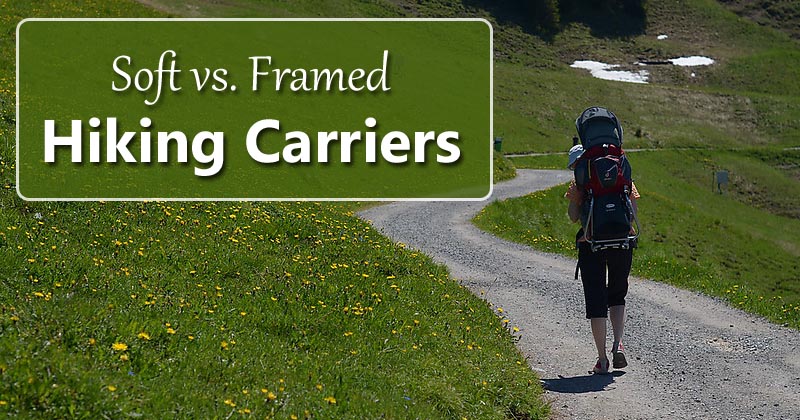
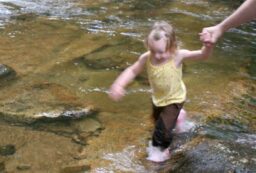
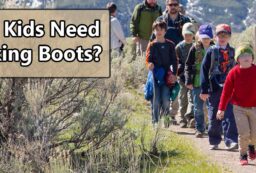
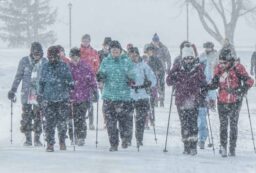







1 Comment
Nicole Karczewski
September 7, 2023 at 4:43 amThis is super helpful. Thank for sharing all of your baby-carrying wisdom from the trail!